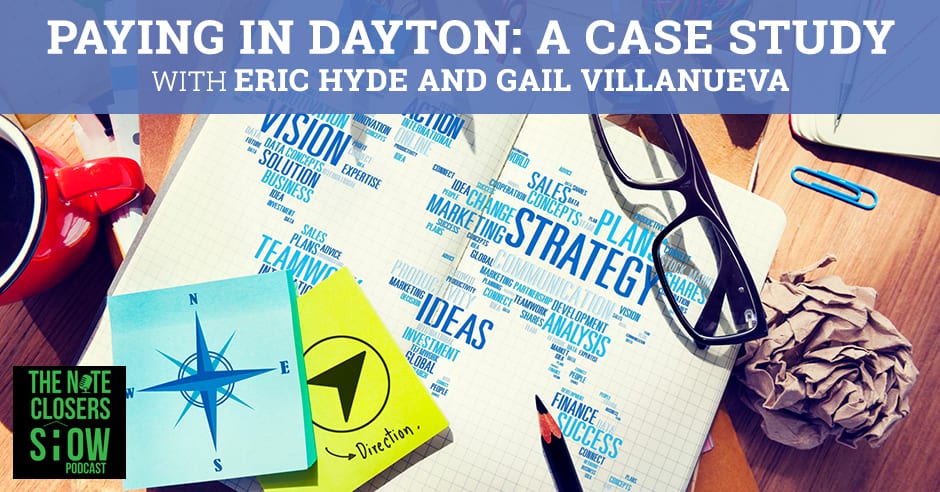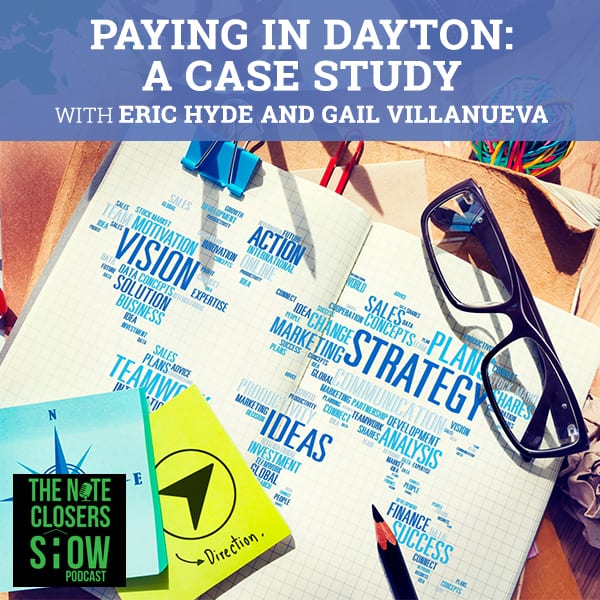
When it gets down to it, people want to see numbers. They want to know how notes are doing the return on investment. They want to know the real world situation. Eric Hyde and Gail Villanueva break down a case study on a note deal that Eric calls Paying in Dayton. They talk about the marketing that went behind it, the finding of a JV partner and what that entails. In the note world, there are not a lot of variances in how marketing is done. Eric and Gail challenge note investors to start thinking outside the box and to start thinking about how to do things different if they want to start to see their note business grow.
—
Listen to the podcast here
Paying In Dayton: A Case Study with Eric Hyde and Gail Villanueva
This is an episode of The Note Closers Show Podcast with Eric Hyde and Gail Villanueva. Eric is going to go through and breakdown a case study from start to finish on what he did for one particular note.
You and I talked and we thought, “What should we talk about?” I want to put out some good content and I know, a group of us have co-hosted Scott’s podcast like this one. There’s been a lot of good content. I didn’t want to duplicate a lot of the things that people were saying. I thought, “What do people want to hear?” The thing it gets down to it, people want to see numbers. They want to know how notes are doing, the return on investment, what’s the real world issue. I took a look at one of mine. It was a recent one that I marketed out a few months ago. I thought I would break it down.
A lot of people wonder how do we find these notes. How do we decide what is a good note? Go what the semantics are behind finding that note and making the deal work? You’re also going to also touch on finding JV partners and how that all goes too.
I’m going to talk about one deal to keep it simple, but in doing so, I’m going to talk about the marketing that went behind it, the finding of a JV partner and what that entails with me and JV-ing with me. I don’t think it’s going to be too different with you or someone else, but this might answer some of those questions. Before I get into this note deal, I want to talk a little bit about my marketing. I know we’ve had a segment on marketing. I’m not going to reinvent the wheel or touch on the same thing they talked about. For me, I don’t buy big pools. I’m onesie-twosie guy. For me, buying a note, I then look for a JV partner on that note. I mark it out a particular deal. Throughout my whole life I’ve always been different. If everybody is zigging, I like to zag. At least I like to look in that zag direction.
In the note world, personally they’re similar and I don’t want to say that we’re all stuffy people, but at the same time there are not a lot of variances in how marketing is done. Gail Greenberg and I, we had a note that we had to sell as a performer, this would be good way to do it. Let’s do it a little different. I decided, “Let me do a video,” and I made a fun video, I posted it out and it sold that week. I realized, “There’s something to this,” and I’m not seeing a lot of marketing videos of people selling notes or even marketing themselves with video. There are people out there doing it, don’t get me wrong, but I want to do something different.
The reason why I’m sharing this is that I know there’s a lot of newer note investors in our audience. I want to challenge you to start thinking outside the box. I want to challenge you to start thinking about how to do things different. If what you’re doing is working, then so be it. If there’s no need to change it, then don’t change it. I know there are a lot of people out there looking for solutions and how do I do that? Think outside the box. Have you seen that show? My wife watches it all the time. It’s one of those fix and flip shows. It’s Chip Gaines and his wife.
I hadn’t watched them, but they destroyed my business model for doing fix and flips myself. If I had $1 million of sponsorship and do a deal in 48 hours, sure. I swayed away from them because it wasn’t to me reality.
I’m not a fix and flipper. I’ve never been a fix and flipper. I bring them up as an example because one of the things that they do, each deal that they put out, they name the house. Chip Gaines will go through and go, “We call this house The Hot Tub House.” I decided to start naming my deals. Put a name to it. One of the deals that I had marketed out, I called it Paying in Dayton. I made a video here in the backyard, “What’s up? Eric Hyde, Paying In Dayton,” and I named it and I’ve done a couple other deals since then. I named the deal which makes it fun because let’s face it, in this business, if you’re not having fun, you’ve got to have fun while you’re doing this.
We’re all here to make money but we’re all here for different reasons. For me, I’m here to make money which equals freedom and more time with my kids. Have some fun in the meantime and for me making videos is fun. Make some good videos, have some fun. Think outside the box. If you are too shy to make a video, but you have a deal you want to mark it out, let me know. I’ll help you out. I thought of that right now. It’s going to cost you, but if you want to go that route, hit me up. We can do something. One of the things that I do when I look at a deal is what are the compensating factors in this deal? Paying in Dayton, the compensating factor was the pay history. There was a payment the month I was reviewing the tape. There’s a good chance somebody is living there. I highlighted the compensating factors. I look at each deal and I look at the compensating factor and then I market to that. That seems to work.

Paying in Dayton: Make some good videos, have some fun. Think outside the box.
This is Paying in Dayton. This was a tape I received back in end of February, early March. The unpaid principal balance was $42,400. Fair market value is $35,000. The P&I was $368 per month, Principal and Interest. I don’t care about taxes, insurance, the payment because that’s not how I make my money. That’s not where I get my return. It’s principal and interest. In looking at those three things, those meet my criteria, and here’s what I’m mean. The fair market value of $35,000, generally speaking, when I do my due diligence, if it’s under $25,000, I don’t look at it.
A lot of people who are students of Scott, they follow that same model. It makes sense. Not to say that I haven’t done some below that level. I find obviously as I moved forward in time, I need to go higher value assets, at least have this minimum. It meets my fair market value. I don’t go off of what the seller says. You always want to make sure that you verify your values. Zillow, Trulia, Realtor, that maybe gives you a snapshot, but you need to get a realtor. You need to get eyes on the property and you need a BPO to tell you what they think, the expert in that area. What’s the value of this house? That’s where I came up with this fair market value of $35,000. $368 monthly P&I, I filter out anything less than $200.
Even so, I’m starting to bump that up. If the P&I payment is less than $200, especially on a JV deal, there’s nothing sexy about receiving $100 a month for your note that is not performing. I like to put some meat on the bone. I like to be able to offer my investor not just a good return, but a fair chunk of money. I mentioned the last payment. This was on the original tape. It had a last payment of March ’18. To me that was huge. I filtered through recent payments. I eliminate anything where there’s not been a payment in the last year. Everybody’s strategy is different. You do the same thing, Gail. What’s your timeframe on last payments?
Twelve months or less. If they even had one payment in twelve months, that’s borderline for me if I want to pursue it. I look at twelve months’ worth of history and see what they’ve been doing. They’ve got to have a payment in there, yes.
For those who may not know, the reason for that is if my number one exit strategy is reinstatement, get them re-performing. I want confirmation that there’s somebody in the home, but payment was two years ago. It’s not to say that’s not a good deal, but chances are it might be an REO, which you might still make money, but you eliminate half your exit strategies right there on the spot. Payment in March of 2018 tells me it’s occupied. This is one of the marketing pieces I did. What I did is I highlighted this payment. If I’m marketing for a JV on this, I don’t need all this fine print of all these different things. I want to highlight something that’s important that an investor is going to say, “Why would I invest in this? Occupied. Last payment was this month, there’s a good chance it’s re-performing.” Those are the numbers.
The obvious thing I know people are probably going to ask is why are you looking at a UPB that is higher than the fair market value?
There are a couple of reasons for that. If it’s upside down, the beauty in that is that there’s a better chance you’re going to work it out with the borrower. There’s incentive for them to stay in the home because this P&I payment of $368 is lower than the current rents. The rents in the area are $650. If I can work with them and even eliminate some of this, remember, I’m the lender. I can negotiate how much they owe. I might decide, “We’ll do a loan mod. For every dollar you pay, I’ll wipe out a dollar.” Whatever the case is, there’s room I can work with. They were underwater, now they’re feeling better about it. There’s motivation for them to stay in this home where they’re paying $368. It might be closer to $500 because there are taxes and insurance. That’s why being upside down is a good one.
I don’t throw out the ones like that too, but I’m sure that somebody would ask, “Why would you go after that?” Thank you for that explanation. I do the same thing.
I talked about the initial numbers. I’m looking at the house, three-bedroom, one-bath, single-family residence, over 1,200-square feet. This is your bread and butter traditional home. This is what I like. Reason being is if I ever take this house back, it’s marketable. Selling a one bedroom, one bath home, there’s a smaller market for that. Not to say that there’s not money to be made there. One of the first ones I did was a one bedroom, one bath. I still own it and I’m making on a return level, it’s probably one of my higher returns. I traditionally go for the bedroom three and two, three and one. The crime in the area is low, market rents are $650 and the taxes are current. It’s important when you do your due diligence. High crime areas, get rid of them.
Not to say you’re not going to make money there, but there’s more to deal with. There are enough assets out there where you can find low crime and you’re not dealing with a gang, drugs being sold or things like that. Market rents, $650. The reason why this is important is if I take this house back, I’ve got several options. Sell it as is, fix it up, sell it or rent it out. I put this into my ROI calculator and part of my exit strategies or when I’m talking to the borrower, borrower outreach, if their payment is less than the rents, that’s incentive for them to stay in the home and pay.
If we’ve got to foreclose, they’re going to have to go rent something and pay more money. I use that to my advantage. The due diligence is you’ve got to know what market rents are. Rentometer is a good one to go to and I talk to my realtor. They know the best thing. That’s why realtors are so important. Taxes are current, another indication that somebody is in the home. Gail, how do you go about finding your rent values? Do you do the same thing?
We use Rentometer. It’s pretty good, but I do have to make a comment as a realtor to Zillow, maybe go to Realtor.com or also Trulia. They have more accurate numbers, is what I’m finding.
What I do when I plug in my address, when I’m doing my due diligence, I don’t go directly to Zillow or Realtor. I just put it in the bar up top, hit enter and it and it gives me those. I click on the link, I look at it, I go back, I click on it and that seems to work for me as opposed to typing each address in each location. I know everybody does a little bit different but that works for me. Now, the city. We’ve got the numbers. We’ve got the house, now the city. Is it a crappy area? Is it a population of a thousand? What’s the city like? What I like about Dayton is population, over 800,000. Plenty of people to choose from to rent, to sell, realtors.
Job growth. When I pick a market, I dive deeper into the city. Job growth is going up in Dayton, not significantly but it is going up. Unemployment rates are dropping and then household income is going up. It meets those criteria of the different technicals that I look at in each city. This is my marketing, to a potential investor, they want to know, “Why are we investing in this city?” University of Dayton, the crime map and then the jobs. You’ve got the Air Force, Premier Health Cancer Network is out there. There are jobs, there’s growth, there’s a university. There’s a variety of economic indicators that tell me that this is a good area to invest in.

Paying in Dayton: It’s important when you do your due diligence to get rid of high crime areas.
Finally, the investment itself. We’ve got the city, we’ve got the numbers, we’ve got the house and now the actual investments. I put out what I’m looking for. In this example, it’s a contract for deed, $11,500. For all-in funding, $15,000. Investors want to know what’s in it for me. I’ve seen some of these flyers where there are all sorts of narrative and this and that, no. Here’s what the investors want to know, a potential JV partner. How much does it cost me? How much am I going to get? How do we exit? That’s it. How much does it cost me? How much am I going to make? How do I get my money back?
They don’t care about my favorite color, my spa or whatever. $15,000 investment, potential. Never guarantee a return. Potential ROI of 44%, 27% based on the P&I payment. If I get them to reinstate, that’s what we’re looking at. After twelve months, sell this as a performer. I throw in the potential net profit. I don’t get into all the details about how I got there, but it’s enough to spark the conversation, the phone call, the email, “Eric, this one looks good. Let’s dive deeper,” and that’s where the conversation comes in.
For those marketing a deal, speak to the investor about what you think they want to hear, how they’re going to make their money and then pick up the phone or when they call, email or reach out because hopefully you’re not blasting this to the world, you’re putting this out to your network of investors. As we do this business, we’re all plate spinners, marketing, deal sourcing, reaching out and building a team. One of the things we do is building this database of investors that when you get a deal, you put it out to them. That’s the investment. We want to know about this actual deal. How’s it doing? What are the timelines? I get a lot of phone calls from people, “I bought this note. It’s taken forever. What do I do?” Here’s what to expect. This is pretty typical with what I’ve found.
I am very glad you’re talking about this, Eric, because people that are starting out in the business or as your JV partners that you’re taking on think it’s cut and dry and it’s immediate. I’m glad that you’re going to discuss and talk about the timelines.
It’s like watching paint dry. It’s the fun, the excitement, “I’ve got a tape, I’m looking, I’m reviewing, I’ve got assets. Let’s do this. Let’s make a bid. Let’s make some money. We put in the offer. We fund it and then we wait.” It’s like watching paint dry. If you’re JV-ing with people, if you’re taking people’s money, you’ve got to communicate with them. Set the expectations. Set a realistic expectation. I don’t tell them, “We funded it, we’re going to get a first payment next week.” No, here’s what it looks like. This is pretty accurate. On this particular deal, we funded this on March 21st. It was boarded about three weeks later on April 11th.
One of the things that I do and I recommend this to people, once you fund your deal, I use Shante over at Madison. I emailed her right away. I send her the soft collateral file and I give her a heads up. “Shante, I’ve got another one for you. Let’s do this together. You’re part of my team. Here you go.” Give her the heads up and then you follow up couple of weeks later. That’s what I did on this one. I emailed her probably the same day I funded it. It was boarded on April 11th. On April 12th, Madison made contact with the borrower. Here’s what I mean. Though it was boarded on the 11th, I think that it was probably boarded the week prior, but it didn’t show up on my portal until the 11th. Here’s why I think that. April 12th, the borrower called into Madison about her loan and the reason being is because they sent the hello letter out.
It prompted her to pick up the phone and in this particular instance, the borrower had questions. “How do I get caught up?” She called in, she had questions. What happened then, Madison puts in their notes, they call me, the lender and say, “The borrower called in. She wants to know what she can do. What are her options?” Whenever you have a borrower that wants to know options to stay in the home, that’s a win-win. At a minimum, you’re looking at least making their normal monthly payment. What I do, and I don’t recommend this to everybody, the next day, once I found out she called in, she had questions and the questions were directed to the lender, me. I decided the next day I reached out to the borrower myself. It’s one of the things that I do personally, I don’t recommend this. If you are new at notes, don’t do this.
That’s a good point because there are certain states where you have to have a debt collector’s license to reach out to the borrowers. Be very careful and cognizant of the laws about debt collection. If you cross over that line, you’re going to be in some deep trouble.
My approach when I do this, I checked with Madison, I talked to Shante, they’re good with it. I checked with my community, we’re good. Here’s what I do, my goal in calling them is a couple of things. I’m gaining intel. I call and for the sake of this, I’ll call her Linda. “Linda, how are you doing? This is Eric.” I don’t go into full detail. I get her story. I build rapport and I want to know what her story was, “What’s going on?” I ask, “I know you had some questions yesterday.” I’m not demanding money. I’m not rude. I’m not a jerk. I’m working with her because I want to protect my investment. I want to protect my investors’ investment and I want to keep the borrower. In this particular situation, she was very appreciative that I reached out to her.
She’s a nurse, she recently got promoted. She was going through some personal stuff and she says, “I don’t know if I can make a double payment, are you okay with a payment and a half?” I said, “It sounds great but you’ve got to show me that you’re serious.” I don’t want to just say. “It sounds good,” and then I never hear from her again, nothing happens. I asked, “When can you do this?” “I can do this today. I just got paid today.” That’s what happened. She sent in a payment, May 10th it was received, $700. Like clockwork, June 6th, the next payment, $700. This is a success. I didn’t get rich on this. My investor isn’t getting rich, but it’s a base hit. A borrower’s in the home, my investor’s making money, I’m making some money and it’s a win-win for everybody.
All of this in two and a half months and it appears that she’s going to continue making these payments. The fact that she’s got this good job, I love it. The reaching out to the borrower, I’m very careful about it. One of the things I do in my day job, I’m in charge of our negotiations team. I like talking to people. I’m nice to people. I want to work with people. My approach is everything and that’s important. For those of you that do decide to go this route, make sure you tread lightly. Treat people with respect and you’d be okay but for the most part, most of you should let your attorneys, let your known servicers take care of that for you.
I’m on that side of letting them do it for an entirely different reason. I’m not so concerned about crossing the line on the debt collection side as I am hearing about people’s hard time stories. They’ll be like, “Don’t worry about it. I’ll talk to my husband, move in with us for a little while until you get.” No, it would not work out for someone like me.
You are a much nicer person than I am, Gail. As a guy, I’m going to be stereotypical here, guys love to solve problems. If the borrower has got some issue or problem, I’m going to work it. I’m going to find a solution. We’ll work it out. I ran into Joel Markovitz in Vegas at the Note Symposium. I was talking about this exact topic and he says, “That’s good. You’re good at that. Here’s the problem, Eric. How are you going to scale?” “I don’t know. I haven’t thought of that.” This is great now but when I hit my 100-loan mark, I cannot be doing this. I do need to let that go to the professionals. At least in the meantime, I’m learning the process. I’m doing more. I’m reaching out to borrower, I’m helping. It works for me now but I recognized in order to scale, I’ve got to get rid of that. I’ve got to quit talking to every borrower and give that control to somebody else.

Paying in Dayton: If you’re JV-ing with people, if you’re taking people’s money, you’ve got to communicate with them.
We have a question, “How are you finding realtors and agents? How do you do them?” I’ll tell you how I do it. How do you do it?
Two ways I do it. I will reach out to you guys who’s got a realtor in the area and that has been the best route. That has worked the best for me. Sometimes I’m in a market where that’s not the case. I go to Zillow, I click on the find a realtor button, I click on go through and I find the realtor with the most stars and then I’d make a phone call. Make a cold call and I call them. I tell them who I am. I tell them what I do, what I’m looking for. When I do this, I don’t offer up money right away. I offer up this idea that I might end up having to take this house back. If I take the house back, I’m going to give you this listing.
What I’m asking for is a drive-by, a photo and an opinion. Little bit of their time, not a lot. I’ve had some realtors that are, “Sounds good. I know exactly about the note business. I’m good with it,” and I’ve had some that say, “What’s in it for me? How about some payment?” I offered up $50 to a guy in Alabama and he said, “Just for that offer, thank you. I’ll refuse the money but I’ll take care of the pictures for you,” and he did. I reach out to network and I go to Zillow. Those are the two options that I do. What about you Gail? How do you go about it?
When I was doing fix and flips, I hate to keep going back to that but it’s relevant, I was having a hard time finding a realtor to work with because most of the realtors don’t like investors. They don’t understand this. I joined eXp Realty to have my license where I could go in and do MLS deals. It ended up eXp Realty’s nationwide, also in Canada now. I tend to rely on going up to the eXp board that we have to find an agent in that area. Only on one occasion it was so remote that they didn’t have an officer yet.
I ended up having to pay for a BPO that didn’t work out well either. I do that. I tell them, “I’m an agent, active, but that’s not what I do on a regular day job anymore. You get the listing and sales side with any deals that I do in that area.” So far, it’s been quite successful for me to have that opportunity to do that. We have a question that most of us hold close to our vest here. What are the main strategies you use to get your tapes?
You’ve got to hustle. Here’s what you’ve got to do: network, market, make phone calls. This job, this industry is not difficult, it’s just a lot of work. If you’re willing to put in the time and the work, you will make things happen. You just got to get out there and hustle.
There are three days a week I reach out to folks and call. A lot of folks don’t like cold calling. I was talking to my spouse about that one day and I said, “Why is that?” He goes, “People don’t like rejection.” I’m not getting rejected. Gail is not getting rejected. What I’m offering somebody if they call and they’re not interested or they don’t have anything, it’s not me, it’s my product or service at the time that I made that phone call. Don’t take it personally, move on.
They say in sales, “Every no, you’re closer to a yes.” Another one I like is, “You either win or you learn.” Do something wrong or they didn’t like it, who cares? Don’t take it personal. Move on. I talked about the house, the city, all these things. Let’s talk about where it is right now. We can project where it’s going to be, but where is it right now? I received a principal and interest payment of $368 in May, I received another one in June. Both those payments had an additional $200 on top of it. In two and half months, we’ve received $1,136. Our purchase price on this was $11,500. The $30 boarding, three months of boarding at $20, that’s $90 total sum. I’m $11,590 into this thing, income of $1,136. We all know ROI. The math formula is your net income divided by your total investment. Thus far, we’ve made 9.8% in two and a half months. If they didn’t make any other payments, we’ve already made 10%.
Is that an annualized rate?
No, that is not an annualized number. That is an ROI. That is my return on my investments in three months. Underneath that you see at this pay, it would be projected on the frontend a 68% ROI. What I mean by frontend is I just mean their payment. I’m not even talking about the exit, when we make a chunk of money when we sell this thing or we take it back if they stopped paying. That’s projected, there might be some hiccups along the way but we’ve already made a better return than my IRA this year or deferred comp at work.
This is why I love the note business. I want to touch on something. If you notice on my servicing fees, $30 boarding, and then if you notice $20 a month. You might think, “You bought this as a non-performing note, why is it only $20 a month?” Here’s what I do. Just because you bought it as a non-performing note does not mean that it needs to be boarded as a non-performing note. Here’s what I mean by that. On the pay history, when I did my due diligence, I had faith that this was going to be performing. I boarded it as a performer. I did not necessarily need their outreach and it worked. The hello letter was sent out, the borrower called in. If there was no contact, then I would have gone to some special servicing and I would have gone a different route, but I didn’t need to pay that $95 a month initially because there was such a good pay history that I was treating it as performing.
That’s a strategy that I use. We do have a question, “Who are you using for servicing?” I use Madison Management myself and Shante Duffy.
I use Madison for everything and they’ve been great. I know somebody asked, “What happened to them? They weren’t getting back?” but I know Shante moved her office. There was some delay there. Not a big deal. If you know your expectations, if you know your timelines and you’re not in a hurry or rush, let the process work, do your follow-up as need be. They’ll get back to you. Shante is good at emailing back within 24 hours, sometimes same day but usually a day later. I have used FCI on some of my JV deals with Gail Greenberg. I did get that experience, but for now I’m happy with Madison, I’m happy with Shante, my account managers and I’m going to keep rolling with it until there’s a need to change. I like keeping everything in one house.
I do too. I’m very pleased with their service, their follow-up and everything myself. That goes both ways. That goes with the investors for us, but I haven’t had people say, “No, I don’t want what you’re asking for.” I’ve had mostly with banks and servicers, asset managers and things where they’re like, “I don’t have anything.” Don’t deal with the big, top ten banks, half the time they don’t know. I’ve done an informal survey with the banking contacts that I have with my businesses. My husband and I run five businesses so I’ve got a few bank accounts. I’ll ask him randomly, “Do you sell your non-performing notes?” They don’t even know there’s a market for that, so they certainly can’t turn somebody into the bank. If it’s a small bank locally, yes. I have to drill down deep because they’ll say, “You mean our REO department?” “No.” You get to make a lot of phone calls. You’re sending lot of emails. That’s what we were talking about with the rejection.

Paying in Dayton: If you’re willing to put in the time and the work, you will make things happen.
I’m going to add one more thing to that too, is that you make a phone call, you are nobody to them. You are nobody to them. It’s like these tape sent from Joe Schmoe, I don’t give him the time of day. Here’s what I will say, “In life, if you want to be somebody, if you want to be known, if you want to be heard, you keep at it. You just do it.” You make a call, they’re hanging up on you, screw you, whatever. Call back. Email something, reach out, they will eventually realize that you mean business. You’re some joker broker that, “This is a solution for your problem,” or whatever the case is.
That’s how I got into note. I got into Scott’s face all the time. He probably got sick of hearing from me and it works. If you want to be somebody, then be somebody. If you want to get in front of these asset managers, then just do it. Try and keep at it. Maybe they have a policy where they deny the first three times you call because they want to know that you called the fourth time. In the Japanese culture, you offer something to somebody, it’s polite to reject it, and then on the third or fourth try, then it’s accepted. That’s the protocol. You never know. You’ve got to keep at it.
We have a question, “Do you typically have a target time to exit agreed to with your JV if you get an asset re-performing? If you have a good re-performer with a JV and want to hold it indefinitely, do you typically let the JV stay in the deal or do you buy them out and put them in a new deal?”
That’s all handled on the frontend, it depends on the investor. It depends on the deal. If you have that conversation upfront with your investor and you know what their goals are, hopefully your goals are the same, then you can work that out. I like the concept of velocity of money. This is how I handle it with my JVs and this is how it was handled when I JV’d with Gail is this. You put some money into it, you make some cashflow. If I can then turn that into a larger sum of money and exit the deal, I’m going to jump into another deal or two. It’s this idea of taking your $30,000, getting some money for the year, getting a good return and then turning that $30,000 into $40,000 or $50,000 and then taking that and buying two and then doubling that.
Generally speaking, that’s my business model. That’s how I do it. It’s spelled out in the JV agreement. It’s spelled out that way. If it came to be that the borrower said, “I want to keep doing the cashflow,” then we have to work out a solution.” Generally speaking, it’s 50-50 JV, cashflow, sells a re-performer and move on. Would you agree, Gail? Is that the same the same way you do it? You have to know what your investor wants and have that conversation upfront.
Yes. My exit strategy is also to sell a re-performer in twelve months, but if they say, “I want to hold it.” Basically, I’ve given them an opportunity to buy me out at the end.
That’s all I have. I wanted to reach out that Paying in Dayton deal was in fact paying. I want to put the numbers out there in that case study. I’ve got high hopes for it moving forward. That’s all I’ve got. Gail, you’ve got anything else you want to add?
I’m really grateful that we were able to get on it. Thanks again Katie and Eric, you did an awesome job. Thank you very much. It’s been informative. You can’t hear this stuff too much because you want to hear from other investors and what their perspective on how they handle deals. We can all learn from each other and you definitely showed that.
I had a good time. Thanks, Gail. See you later. Take care.
Important Links
- Eric Hyde
- Gail Villanueva
- Gail Greenberg
- Zillow
- Trulia
- Realtor
- Rentometer
- Realtor.com
- Madison
- Joel Markovitz
- eXp Realty
- Katie Moton
About Eric Hyde

First and foremost, I am a DAD to my beautiful boys, Aidan and Liam, and husband to my wife, Lily. Day to day I am a police sergeant for the City of Gardena and have done so for the last 15 years. Life has many opportunities and most do not come walking through the front door. I believe opportunity is created which is why I created AW Notes, LLC, which is my note investing company.
I purchase non performing, first lien residential mortgage notes and because they are non performing I am able to purchase these at a steep discount. This allows me, through my attorneys and loan servicing companies, to work with borrowers to keep them in their homes, if they wish. This is always our # 1 exit strategy. However, there are many more exits. But I will not get into that here.
If you are interested in learning a bit more, please visit my website at www.awnotes.com. Click ‘videos’ for educational videos.
About Gail Villanueva
 Gail the Note Gal (Noteworthy Investments, LLC) is a privately held company specializing in the purchase of non-performing debt secured by real estate in most of the major metroplexes and emerging markets across the country. We partner with investors to purchase these assets and deliver to them consistent high returns. All of our investments are secured by the underlying properties and we purchase the non-performing debt at well below market value. We are able to acquire these discounts due to our relationships with banks, hedge funds, and other investors.
Gail the Note Gal (Noteworthy Investments, LLC) is a privately held company specializing in the purchase of non-performing debt secured by real estate in most of the major metroplexes and emerging markets across the country. We partner with investors to purchase these assets and deliver to them consistent high returns. All of our investments are secured by the underlying properties and we purchase the non-performing debt at well below market value. We are able to acquire these discounts due to our relationships with banks, hedge funds, and other investors.

